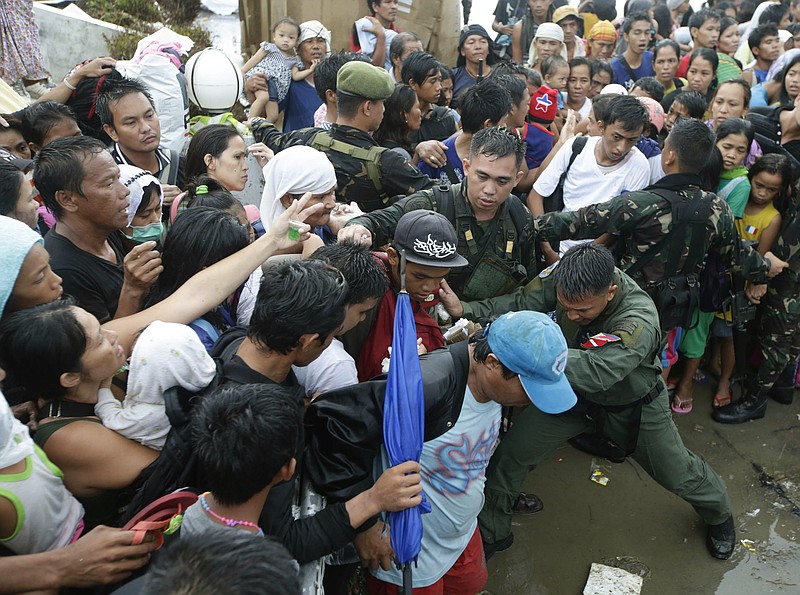TACLOBAN, Philippines (AP) - Desperately needed food, water and medical aid are only trickling into this city that took the worst blow from Typhoon Haiyan, while thousands of victims jammed the damaged airport Tuesday, seeking to be evacuated.
"We need help. Nothing is happening. We haven't eaten since yesterday afternoon," pleaded a weeping Aristone Balute, an 81-year-old woman who failed to get a flight out of Tacloban for Manila, the capital. Her clothes were soaked from a pouring rain and tears streamed down her face.
Five days after what could be the Philippines' deadliest disaster, aid is coming - pallets of supplies and teams of doctors are waiting to get into Tacloban - but the challenges of delivering the assistance means few in the stricken city have received help.
"There is a huge amount that we need to do. We have not been able to get into the remote communities," U.N. humanitarian chief Valerie Amos said in Manila, launching an appeal for $301 million to help the more than 11 million people estimated to be affected by the storm.
"Even in Tacloban, because of the debris and the difficulties with logistics and so on, we have not been able to get in the level of supply that we would want to. We are going to do as much as we can to bring in more," she said. Her office said she planned to visit the city.
Presidential spokesman Edwin Lacierda said relief goods were getting into the city, and the supply should increase now that the airport and a bridge to the island were open.
"We are not going to leave one person behind - one living person behind," he said. "We will help, no matter how difficult, no matter how inaccessible."
Tacloban, a city of about 220,000 people on Leyte island, bore the full force of the winds and the tsunami-like storm surges Friday. Most of the city is in ruins, a tangled mess of destroyed houses, cars and trees. Malls, garages and shops have all been stripped of food and water by hungry residents.
The loss of life appears to be concentrated in Tacloban and surrounding areas, including a portion of Samar island that is separated from Leyte island by a strait. It is possible that other devastated areas are so isolated they have not yet been reached.
In Cebu, to the southwest, the Philippine air force has been sending three C-130s back and forth to Tacloban from dawn to dusk, and had delivered 400,000 pounds of relief supplies, Lt. Col. Marciano Jesus Guevara said. A lack of electricity in Tacloban means planes can't land there at night.
Guevara said the C-130s have transported nearly 3,000 civilians out of the disaster zone, and the biggest problem in Tacloban is a lack of clean drinking water.
"Water is life," he said. "If you have water with no food, you'll survive."
Doctors in Tacloban said they were desperate for medicine. At small makeshift clinic with shattered windows beside the city's ruined airport tower, army and air force medics said they had treated around 1,000 people for cuts, bruises, lacerations and deep wounds.
"It's overwhelming," said air force Capt. Antonio Tamayo. "We need more medicine. We cannot give anti-tetanus vaccine shots because we have none."
The longer survivors go without access to clean water, food, shelter and medical help, the greater chance of disease breaking out and people dying as a result of wounds sustained in the storm.
Thousands of typhoon victims were trying to get out of Tacloban. They camped at the airport and ran onto the tarmac when planes came in, surging past a broken iron fence and a few soldiers and police trying to control them. Most didn't make it aboard the military flights out of the city.
The official death toll from the disaster rose to 1,774 on Tuesday, though authorities have said they expect that to rise markedly. They fear estimates of 10,000 dead are accurate and might be low.
The dead, decomposing and stinking, litter the streets or are buried in the debris.
There is also growing concern about recovering corpses from throughout the disaster zone. "It really breaks your heart when you see them," said Maj. Gen. Romeo Poquiz, commander of the 2nd Air Division.
"We're limited with manpower, the expertise, as well as the trucks that have to transport them to different areas for identification," Poquiz said. "Do we do a mass burial, because we can't identify them anymore? If we do a mass burial, where do you place them?"
Damaged roads and other infrastructure are complicating relief efforts. Government officials and police and army officers are in many cases among the victims themselves, hampering coordination. The typhoon destroyed military buildings that housed 1,000 soldiers in Leyte province.
There were other distractions, including a jailbreak in Tacloban. Army Brig. Gen. Virgilio Espineli, the deputy regional military commander, said he wasn't sure how many of the 600 inmates fled.
The U.N. said it had released $25 million in emergency funds to pay for shelter materials and household items, and for assistance with the provision of health services, safe water supplies and sanitation facilities.
The USS George Washington is headed toward the region with massive amounts of water and food, but the Pentagon said the aircraft carrier won't arrive until Thursday. The U.S. also said it is providing $20 million in immediate aid.
Aid totaling tens of millions of dollars has been pledged by many other countries, including Japan, Australia and Britain, which is sending a Royal Navy vessel.

